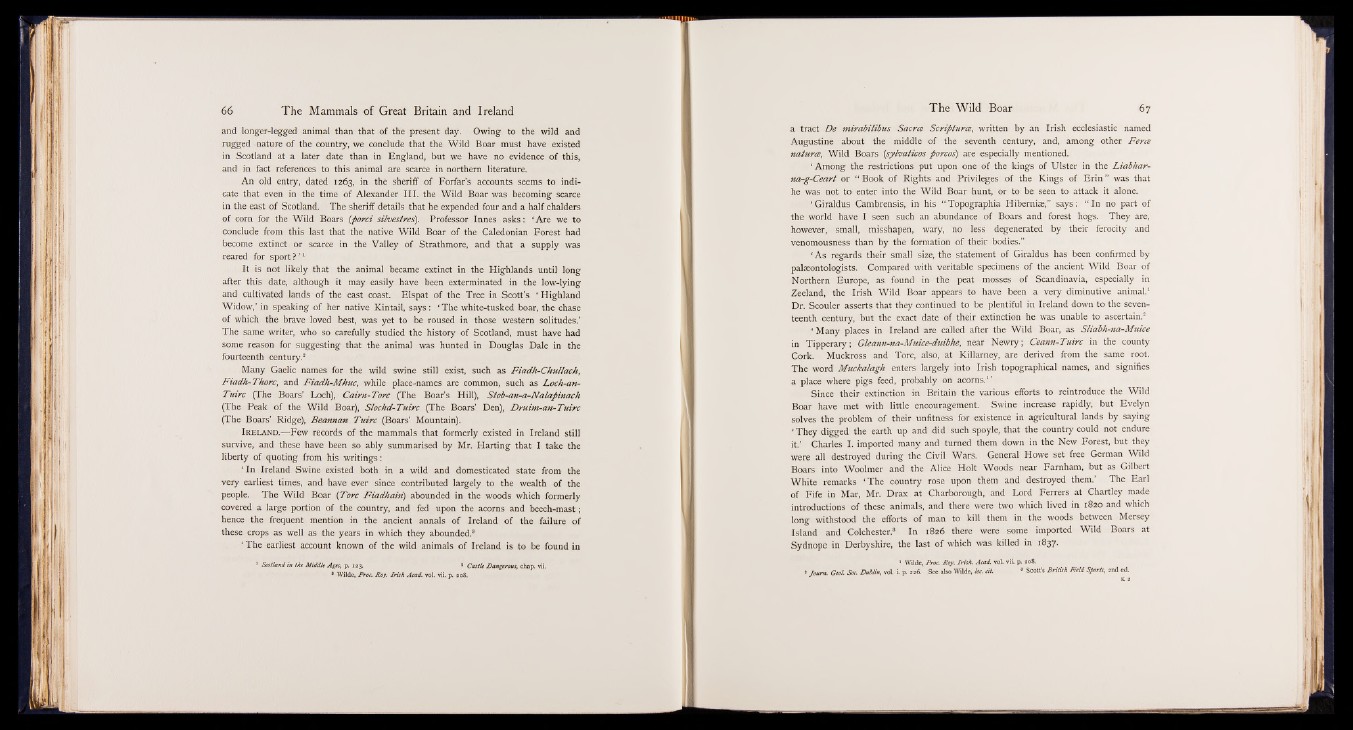
and longer-legged animal than that of the present day. Owing to the wild and
nigged nature of the country, we conclude that the Wild Boar must have existed
in Scotland at a later date than in England, but we have no evidence of this,
and in fact references to this animal are scarce in northern literature.
An old entry, dated 1263, in the sheriff of Forfar's accounts seems to indicate
that even in the time of Alexander III. the Wild Boar was becoming scarce
in the east of Scotland. The sheriff details that he expended four and a half chalders
of corn for the Wild Boars {fo rd silvestres). Professor Innes asks: ‘ Are we to
conclude from this last that the native Wild Boar of the Caledonian Forest had
become extinct or scarce in the Valley of Strathmore, and that a supply was
reared for sport?'1
It is not likely that the animal became extinct in the Highlands until long
after this date, although it may easily have been exterminated in the low-lying
and cultivated lands of the east coast. Elspat of the Tree in Scott’s ‘ Highland
Widow,’ in speaking of her native Kintail, says: ‘ The white-tusked boar, the chase
of which the brave loved best, was yet to be roused in those western solitudes.’
The same writer, who so carefully studied the history of Scotland, must have had
some reason for suggesting that the animal was hunted in Douglas Dale in the
fourteenth century.2
Many Gaelic names for the wild swine still exist, such as Fiadh-Chullach,
Fiadh-Thorc, and Fiadh-Mhuc, while place-names are common, such as Loch-an-
Tuirc (The Boars’ Loch), Cairn-Torc (The Boar’s Hill), Stob-an-a-Nalafiinach
(The Peak of the Wild Boar), Slochd-Tuirc (The Boars’ Den), Druim-an-Tuirc
(The Boars’ Ridge), Beannan Tuirc (Boars’ Mountain).
I r e l a n d .— Few records of the mammals that formerly existed in Ireland still
survive, and these have been so ably summarised by Mr. Harting that I take the
liberty of quoting from his writings:
‘ In Ireland Swine existed both in a wild and domesticated state from the
very earliest times, and have ever since contributed largely to the wealth of the
people. The Wild Boar {Tore Fiadhain) abounded in the woods which formerly
covered a large portion of the country, and fed upon the acorns and beech-mast;
hence the frequent mention in the ancient annals of Ireland of the failure of
these crops as well as the years in which they abounded.8
‘ The earliest account known of the wild animals of Ireland is to be found in
1 Scotland in the Middle Ages, p. 123. * Castle Dangerous, chap. vii.
* Wilde, Proc. Hoy. Irish Acad. vol. vii. p. 208.
a tract De mirabilibus Sacra Scriptures, written by an Irish ecclesiastic named
Augustine about the middle of the seventh century, and, among other Feree
natures, Wild Boars {sylvaticos porcos) are especially mentioned.
‘ Among the restrictions put upon one of the kings of Ulster in the Liabhar-
na-g-Ceart or “ Book of Rights and Privileges of the Kings of Erin ” was that
he was not to enter into the Wild Boar hunt, or to be seen to attack it alone.
‘ Giraldus Cambrensis, in his “ Topographia Hiberniae,” says: “ In no part of
the world have I seen such an abundance of Boars and forest hogs. They are,
however, small, misshapen, wary, no less degenerated by their ferocity and
venomousness than by the formation of their bodies.”
‘ As regards their small size, the statement of Giraldus has been confirmed by
palaeontologists. Compared with veritable specimens of the ancient Wild Boar of
Northern Europe, as found in the peat mosses of Scandinavia, especially in
Zeeland, the Irish Wild Boar appears to have been a very diminutive animal.1
Dr. Scouler asserts that they continued to be plentiful in Ireland down to the seventeenth
century, but the exact date of their extinction he was unable to ascertain.2
‘ Many places in Ireland are called after the Wild Boar, as Sliabh-na-Muice
in Tipperary; Gleann-na-Muice-duibhe, near Newry; Ceann-Tuirc in the county
Cork. Muckross and Tore, also, at Killarney, are derived from the same root.
The word Muckalagh enters largely into Irish topographical names, and signifies
a place where pigs feed, probably on acorns.1’
Since their extinction in Britain the various efforts to reintroduce the Wild
Boar have met with little encouragement. Swine increase rapidly, but Evelyn
solves the problem of their unfitness for existence in agricultural lands by saying
‘ They digged the earth up and did such spoyle, that the country could not endure
it.’ Charles I. imported many and turned them down in the New Forest, but they
were all destroyed during the Civil Wars. General Howe set free German Wild
Boars into Woolmer and the Alice Holt Woods near Farnham, but as Gilbert
White remarks ‘ The country rose upon them and destroyed them.’ The Earl
of Fife in Mar, Mr. Drax at Charborough, and Lord Ferrers at Chartley made
introductions of these animals, and there were two which lived in 1820 and which
long withstood the efforts of man to kill them in the woods between Mersey
Island and Colchester.8 In 1826 there were some imported Wild Boars at
Sydnope in Derbyshire, the last of which was killed in 1837.
* Wilde, Proc. Roy. Irish. Acad. vol. vii. p. 208.
* Joum. Geol. Soc. Dublin, vol. i. p. 226. See also Wilde, loc. cit. * Scott’s B ritish Field Sjorts, 2nd ed.